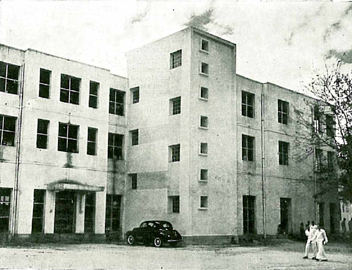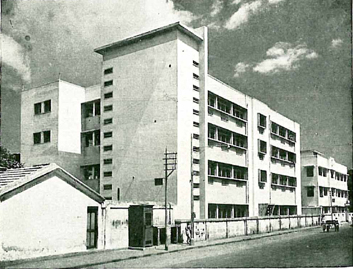|
The auto I'm travelling in is rickety and falling apart, and our travels into the dusty, congested and uneven north Chennai roads make it even more bone-shaking. Karuppan, my 'chauffeur', affirms rather emphatically, but quite disquietingly, "Stanley aspathirikka poganum? Accidentinna naanga angethan povom!" (Want to go to Stanley Hospital? For all accident cases, we go there only!). Stanley is one of the oldest centres in India for medical treatment and education, the seeds for it having been sown as early as 1797 by the East India Company.
With nearly 1300 beds for in-patient treatment, the hospital now has an out-patient attendance of around 5000 patients a day, a unique 8-storey surgical complex equipped to perform up to 40 surgeries simultaneously, a separate paediatrics block with all specialities under one roof, and the RSRM Hospital attached for obstetrics and gynaecology care. Its Department of Urology performs up to fifty kidney transplants a year. Its Department of Surgical Gastroenterology, the first in India to perform a successful liver transplant, is also the first among hospitals/hospital departments in India to obtain the ISO 9001 certification! Stanley Medical College is rated one among the top medical colleges in the country, its Institute for Research and Rehabilitation of Hand and the Department of Plastic Surgery (IRRH & DPS), one of the best centres in South and Southeast Asia.
 |
Monegar Choultry |
An early record notes that the Government Stanley Medical College and Hospital originated as what was called the Native Infirmary. This was the result of Asst. Surgeon John Holen Underwood proposing in 1797 the creation of a hospital and dispensary in the premises of the Monegar Choultry. When he offered to construct the buildings himself on government-provided land and "pay rental not exceeding 100 pagodas a month", the Government agreed, provided the operational cost was met by donations. With the hospital taking shape by 1799, Underwood was appointed Superintendent of the 80-bed Infirmary which was to be subject to inspection by the Medical Board.
Support was forthcoming from distinguished persons, like the Nawab of Arcot, and business houses. The sick were treated in three different establishments, a dispensary for out-patients, half a dozen sheds for in-patients and special wards for chronic cases. Within a month of formal establishment, the Infirmary had nearly 90 inpatients. By the end of 1807, the Committee of the Native Infirmary represented to Government on the fact that voluntary contributions had diminished and that funds for the Infirmary needed to be increased. It requested the grant of a village for its permanent support. A suggestion was made to amalgamate the Monegar Choultry and Native Infirmary and the two were consolidated on November 1, 1809.
The new institution was designated 'The Madras Infirmary and Native Poor Asylum', and a surgeon "on salary of 80 pagodas and palankeen allowance of 20 pagodas appointed". At that point, there was also "an Idiots Asylum, a Lazaretto or Leper Hospital, and a Foundling ward for the accommodation of pauper children". It was urged by the Board of Directors of Monegar Choultry "that the Charity be relieved of charge of the surgeon's salary as the Infirmary had become the hospital for the entire population of Black Town and really paid for what Government itself provided in other localities." In July 1858, the request was accepted.
Various additions were made to the Native Infirmary from 1868. Four new wards with 40 beds for female patients were constructed. The Northcote Wards, two model wards, for males and females were furnished at Rs. 1000 received from Sir Stafford Northcote, then Secretary of State, as donation. The cost of furnishing the Napier Ward was similarly met from a donation from Governor Napier. In 1882, the Raja of Vizianagaram defrayed the expenses for bringing water from Red Hills to the hospitals. In the 1880s, the Rajah Sir Ramaswamy Mudaliar Lying-in Hospital was added, named after its donor. A surgeon, an apothecary and a superintendent were appointed by 1889.
In 1910, on reference through the Surgeon General of the Government of Madras, the Board of Directors transferred the Native Infirmary (with an endowment of Rs. 66,887-13-5 to the control of the Government.
When the Government acquired the Monegar Choultry site for the construction of what it decided to call the Government Royapuram Hospital, a line of buildings was built by Government to house the choultry in the neigbouring Rajah of Venkatagiri compound.
It has been recorded that "the Superintendent of the Choultry Mr Coshan was indirectly responsible for the coming up of the hospital in a way. His array of facts, and lucid representation of statistics formed the basis of statements that completely convinced authorities that a new Hospital was indicated." By a stroke of good fortune, affairs at this juncture "were in the hands of two of the greatest administrators Madras had ever had the good fortune to possess – Surgeon General William Bannermann and Sir Alexander Cardew, then Under Secretary."
Two big factors favouring a new hospital were the availability of a large tract of land close by for building purposes and, more crucially, the existence on part of it of what was the Auxiliary Royapuram Medical School (1877), which trained compounders and sub-assistant surgeons. In 1913, there were 250 or so pupils in the school, which had minimal facilities (only two low power microscopes for teaching and one with an oil immersion lens kept under lock and key for the use of District Surgeons!).
The old building which accommodated 51 beds for men and 24 for women was inspected by Governor Lord Carmichael in January 1912 who condemned the whole place as being "thoroughly unsuitable, antiquated and not in keeping with the modern requirements of a hospital" and sanctioned in its place the construction of an up-to-date institution. This led to Government sanctioning Rs, 3 lakh for construction of a medium hospital with 135 beds and an up-to-date operation theatre.
Lt Col R. Bryson, FRCS (appointed as Surgeon in 1913, and later Superintendent of Royapuram Medical School years later), recorded in the 1963 souvenir, "If the foundations had not begun then and if the building had not been pressed at a feverish pace during 1914, the Great War would certainly have stopped completely, if it had not considerably hampered, the whole project. If it had not been for the students in the old bullet factory, I am pretty certain that nothing like the present Royapuram Hospital could ever have come into existence!"
On December 19, 1913, Governor Pentland laid the foundation stone for the Royapuram Hospital and Medical School. Costing Rs. 3,56,750, the new buildings were completed in 1917. The first of them, the Pentland Block, was opened by Lord Pentland on July 17.1917, and it provided beds for 72 men, 72 women and 16 children.
 |
 |
New female medical block, 1964. |
New nurses' quarters, 1964. |
The first proposal for additional accommodation was sent in 1919 for constructing Septic and Chronic Wards with 198 beds. After a good deal of correspondence, the Government sanctioned only a ground floor of 52 beds at a cost of Rs. 1,55,000. But it did not go through for many reasons, financial stringency being one of them. In 1921, the Nurses' Quarters were constructed at a cost of Rs. 1,09,890 to accommodate 15 staff nurses and 17 probationers. A surgical museum of instruments soon came up. Some great names of the period were Dr. Nayudu, Dr. A. L. Mudaliar, and Dr. S.M. Trasi. There was no X-Ray Department but there were Dental and Venereal Disease Departments. An additional block of 104 beds with a clinical school (Bryson School) attached to it was built at a cost of Rs 3,82,135 and opened by Governor Lord Willingdon on 1.1.1924, followed by a new OP Department at a cost of Rs 2,05,180 opened by Lady Willingdon.
A second nurses' block to accommodate 20 nurses was opened on February 15, 1932. In August 1935, Capt. P. Krishnaswami revived the proposal for construction of a Septic Block. The plans/estimates were prepared by Consulting Architect Jacob Fernandez and Government sanctioned Rs.1,40,000 on January 22, 1937. The same year, Government "was pleased to sanction the construction of the Hope Block of 112 beds and 2 Operation Theatres at a cost of Rs. 2½ lakh."
Four in-patient wards to accommodate 92 patients were not long afterwards constructed, equipped and occupied. The Out-Patient Block was expanded with the construction of an additional wing for an operation theatre, ENT, medical, surgical and dental departments and a dispensary. A separate maternity hospital, the RSRM Lying-In Hospital, was built close by at a cost of Rs. 20 lakh, and the women's medical wards were located there. A steam laundry at a cost of Rs. 7.5 lakh was constructed to get patients' clothes washed properly and as frequently as possible. By April 25, 1939, Government had sanctioned another Rs. 95,000 for a first floor construction to meet the increasingly enormous overcrowding. Bed strength also rose from 462 to 724.
Dr. N.S. Narasimhan recalls in a souvenir the happy period of his service in the Royapuram Hospital and Medical School from 1919 to 1929. "Initially, the OP Department consisted of the old Black Town dispensary, with the name changed to George Town Dispensary under the Corporation. The wards consisted of the first block in front with a block of four small wards behind the first block and an OT. The second block was opened by the Raja of Panagal. Two chronic wards, one male and one female, have at present been absorbed in ophthal beds. The Medical School building was in the present blood transfusion service. The RSRM Hospital was in the present X-Ray Department. Staff consisted of an IMS Superintendent for School and Hospital, an RMO for RSRM and RMO for RH, besides lecturers for different subjects and assistants. This reorganised scheme was due to the work of Maj. Gen. E.W.C. Bradfield, IMS.
Between 1937 and 1939, the new clinics opened included those for venereal, leprosy, dental, ear, nose & throat, and ophthalmic, and separate clinics were organised for Departments of Medicine, Surgery, TB, Dermatology, Electro-Cardiography and Orthopaedics. In an early record, Dr. R. Mahadevan, Professor of Operative Surgery, notes, "As far as known from published records the first successful heart operation in India was done in Stanley Hospital on November 10, 1948, on a girl of 11 years with persistent patent ductus arteriosus. The girl is known to be doing well and is now married and has children."
On the recommendation of the general inspection commission of the University of Madras, a new addition to the Stanley Medical College came in the form of the newly constructed Maternity Hospital with bed strength of 275 at a cost Rs.32 lakh in June 1956. The 1963 souvenir records increase in bed strength which "'now has 840 sanctioned beds besides accommodating 100 more extra patients."
(To be continued)
From famine to succour
In 1781, Madras experienced one of the worst famines in its history, affecting one-third of the population. Black Town, the most densely populated and poorest quarter of the city, was most badly hit. In 1782, the Government of Madras Presidency and St Mary's Church in the Fort jointly launched what was perhaps the first-ever organised charity in India in a small building rented by the Famine Relief Committee just outside the walls of Black Town. As part of relief operations, kanji (rice gruel) was served to people in a thotti (vessel) – and so the name 'kanji thotti' choultry or resthouse. This rented house later became the Monegar Choultry, believed to be named after a village headman, a manugakkaran ('monegar'), who ran a gruel centre there for the destitute. Many years later, when Stanley Hospital came into being in the same campus, locals called it the 'kanji thotti hospital'!
|